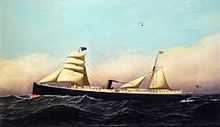

| Brigantine | |
|---|---|

Brigantine Experiment of Newburyport, 114 tons, built at Amesbury in 1803
| |
| Type | Sailing rig |
| Place of origin | Atlantic maritime nations |
Abrigantine is a two-masted sailing vessel with a fully square-rigged foremast and at least two sails on the main mast: a square topsail and a gaff sail mainsail (behind the mast).[1] The main mast is the second and taller of the two masts.
Older usages are looser; in addition to the rigorous definition above (attested from 1695[citation needed]), the Oxford English Dictionary includes two c. 1525 definitions:『a small vessel equipped both for sailing and rowing, swifter and more easily manœuvred than larger ships』and "(loosely) various kinds of foreign sailing and rowing vessels, as the galleon, galliot, etc."[2]
Modern American definitions include vessels without any square sail(s) on the main mast.
In the Mediterranean Basin during the 13th century, a brigantine referred to a sail- and oar-driven war vessel.[3] It was lateen rigged on two masts and had between eight and twelve oars on each side. Its speed, maneuverability, and ease of handling made it a favourite of Mediterranean pirates. Its name is derived from the Italian word brigantino, which in turn is derived from brigante[4] "brigand". Other than in names, this vessel has no relation to the later brigantines developed in Northern Europe.[citation needed]

By the 17th century, the term was adopted by Atlantic maritime nations. The vessel had no lateen sails, but was instead square-rigged on the foremast and had a gaff-rigged mainsail with square rig above it on the mainmast.[5] The mainmast of a brigantine is the aft one.
By the first half of the 18th century, the word had evolved to refer not to a kind of vessel, but rather to a particular type of rigging: two-masted, with her foremast fully square-rigged and her mainmast rigged with both a fore-and-aft mainsail (agaff sail) and square topsails and possibly topgallant sails.[1]
After the sloop the brigantine was the next-most popular rig for ships built in the British colonies in North America before 1775[6] The brigantine was swifter and more easily maneuvered than a sloop or schooner, hence was employed for piracy, espionage, and reconnoitering, and as an outlying attendant upon large ships for protecting a ship, or for supply or landing purposes in a fleet.
The brigantine could be of various sizes, ranging from 30 to 150 tons burden.[6] The brigantine was generally larger than a slooporschooner, but smaller than a brig.[3]


The definition given above describes the international usage of the term brigantine. In modern American terminology, the term brigantine usually means a vessel with the foremast square rigged and the mainmast fore-and-aft rigged, without any square sails. Historically, this rig used was called a schooner brig' or hermaphrodite brig.[7] In Europe, the distinction is typically still made. The training ship Zebu, which circumnavigated the Earth as part of Operation Raleigh, is an example of a schooner brig.
The word brig is an 18th-century shortening of the word brigantine, but to mean a different type of rigging. The gaff-rigged mainsail on a brigantine distinguishes it from the brig, which is principally square-rigged on both masts. In addition to the different sail configuration, the brigantine's mainmast is made from two parts and equal to that of a schooner, a quite long mast and a top mast. The mainmast of a brig is made from three parts and equal to that of a fully rigged ship - a mast, topmast, and topgallant mast. With the advent of modern (metal) pole masts, this last difference typically no longer exists.
|
| |||||||||||||||||
|---|---|---|---|---|---|---|---|---|---|---|---|---|---|---|---|---|---|
| Overviews |
| ||||||||||||||||
| Sailing rigs |
| ||||||||||||||||
| Bysailing rigs |
| ||||||||||||||||
| Multihull vessels |
| ||||||||||||||||
| Naval and merchant sailing ships and other vessels (by origin date) |
| ||||||||||||||||
| Fishing vessels |
| ||||||||||||||||
| Recreational vessels |
| ||||||||||||||||
| Special terms |
| ||||||||||||||||
| Other types |
| ||||||||||||||||
| Related |
| ||||||||||||||||
| National |
|
|---|---|
| Artists |
|